Analysis of Vine Nutrition and Productivity Based on Statistical Indicators
Abstract
:1. Introduction
2. Materials and Methods
2.1. Soil and Climate Conditions
2.2. Biological Material and the Plantation System
2.3. Fertilization Variants
2.4. Leaf Sampling and Determination
2.4.1. Physiological Indices
2.4.2. Mineral Element Contents in Leaves
2.5. Elements of Productivity and Quality
2.6. Statistical Analysis of Experimental Data
3. Results
3.1. Factors Hierarchy—Nutritional Elements and Physiological Indices
3.2. Factor Value Verification Tests
4. Discussion
5. Conclusions
Author Contributions
Funding
Data Availability Statement
Acknowledgments
Conflicts of Interest
References
- Maia, M.; Ferreira, A.E.; Laureano, G.; Marques, A.P.; Torres, V.M.; Silva, A.B.; Matos, A.R.; Cordeiro, C.; Figueiredo, A.; Silva, M.S. Vitis vinifera “Pinot noir” leaves as a source of bioactive nutraceutical compounds. Food Funct. 2019, 10, 3822–3827. [Google Scholar] [CrossRef] [PubMed]
- Insanu, M.; Karimah, H.; Pramastya, H.; Fidrianny, I. Phytochemical compounds and pharmacological activities of Vitis vinifera L.: An updated review. Biointerface Res. Appl. Chem. 2021, 11, 13829–13849. [Google Scholar] [CrossRef]
- Li, H.; Wei, Y.; Zhang, H.; Chen, H.; Meng, J. Fine-grained classification of grape leaves via a pyramid residual convolution neural network. Int. J. Agric. Biol. Eng. 2022, 15, 197–203. [Google Scholar] [CrossRef]
- Arrobas, M.; Ferreira, I.Q.; Freitas, S.; Verdial, J.; Rodrigues, M.Â. Guidelines for fertilizer use in vineyards based on nutrient content of grapevine parts. Sci. Hortic. 2014, 172, 191–198. [Google Scholar] [CrossRef]
- Niemiec, M.; Chowaniak, M.; Zuzek, D.; Komorowska, M.; Mamurovich, G.S.; Gafurovich, K.K.; Usmanov, N.; Kamilova, D.; Rahmonova, J.; Rashidov, N. Evaluation of the chemical composition of soil as well as vine leaves and berries from selected commercial farms in the Republic of Tajikistan. J. Elem. 2020, 25, 675–686. [Google Scholar] [CrossRef]
- Cuq, S.; Lemetter, V.; Kleiber, D.; Levasseur-Garcia, C. Assessing macro- (P, K, Ca, Mg) and micronutrient (Mn, Fe, Cu, Zn, B) concentration in vine leaves and grape berries of vitis vinifera by using near-infrared spectroscopy and chemometrics. Comput. Electron. Agric. 2020, 179, 105841. [Google Scholar] [CrossRef]
- Richardson, J.B.; Chase, J.K. Transfer of macronutrients, micronutrients, and toxic elements from soil to grapes to white wines in uncontaminated vineyards. Int. J. Environ. Res. Public Health 2021, 18, 13271. [Google Scholar] [CrossRef]
- Karimi, R.; Saberi, A.; Khadivi, A. Effects of foliar spray of agricultural grade mineral oil in springtime, in combination with potassium and calcium sulfates on the phenological and biophysical indices of clusters, and foliar nutritional levels in grapevine (Vitis vinifera L.) cv. Sultana (Id. Thompson seedless, Sultanina). Biol. Res. 2021, 54, 28. [Google Scholar] [CrossRef]
- Olego, M.A.; Quiroga, M.J.; Sánchez-García, M.; Cuesta, M.; Cara-Jiménez, J.; Garzón-Jimeno, G.-J. Effects of overliming on the nutritional status of grapevines with special reference to micronutrient content. OENO One 2021, 55, 2. [Google Scholar] [CrossRef]
- Porro, D.; Bertoldi, D.; Bottura, M.; Pedò, S. Five-year period of evaluation of leaf mineral concentrations in resistant varieties in Trentino (Northeastern Italy). BIO Web Conf. 2022, 44, 01002. [Google Scholar] [CrossRef]
- Ramírez, P.M.; Ibáñez, J.D.l.H. Nutrient content of vineyard leaves after prolonged treated wastewater irrigation. Agronomy 2023, 13, 620. [Google Scholar] [CrossRef]
- Schönbeck, L.; Arteaga, M.; Mirza, H.; Coleman, M.; Mitchell, D.; Huang, X.; Ortiz, H.; Santiago, L.S. Plant physiological indicators for optimizing conservation outcomes. Conserv. Physiol. 2023, 11, 073. [Google Scholar] [CrossRef]
- Ennaji, O.; Vergütz, L.; Allali, A.E. Machine learning in nutrient management: A review. Artif. Intell. Agric. 2023, 9, 1–11. [Google Scholar] [CrossRef]
- Calzarano, F.; Amalfitano, C.; Seghetti, L.; Cozzolino, V. Nutritional status of vines affected with esca proper. Phytopathol. Mediterr. 2009, 48, 20–31. [Google Scholar]
- Yildiz, H.; Cakir, O.; Kubra, C.; Karatas, N. The effect of grapevine (Vitis vinifera L.) Varieties on the Bioactive Properties and Mineral Content of Various Vine Leaves Cultivated in Turkey. Available online: https://ssrn.com/abstract=4206725 (accessed on 18 February 2024). [CrossRef]
- Donini, L.M.; Dernini, S.; Lairon, D.; Serra-Majem, L.; Amiot, M.-J.; del Balzo, V.; Giusti, A.-M.; Burlingame, B.; Belahsen, R.; Maiani, G.; et al. A consensus proposal for nutritional indicators to assess the sustainability of a healthy diet: The mediterranean diet as a case study. Front. Nutr. 2016, 3, 37. [Google Scholar] [CrossRef] [PubMed]
- Aldaya, M.M.; Ibañez, F.C.; Domínguez-Lacueva, P.; Murillo-Arbizu, M.T.; Rubio-Varas, M.; Soret, B.; Beriain, M.J. Indicators and recommendations for assessing sustainable healthy diets. Foods 2021, 10, 999. [Google Scholar] [CrossRef]
- Albakaa, A.R.M.; Ameen, D.S.M.; Abed, N.K.; Jabbar, Z.A.; Musaa, L.A. Quantification of Ca, K, Mg, Zn and Fe elements in grape leaves from different regions of Iraq by atomic absorption spectroscopy. J. Phys. Conf. Ser. 2021, 1853, 012018. [Google Scholar] [CrossRef]
- Maia, M.; Cavaco, A.R.; Laureano, G.; Cunha, J.; Eiras-Dias, J.; Matos, A.R.; Duarte, B.; Figueiredo, A. More than just wine: The nutritional benefits of grapevine leaves. Foods 2021, 10, 2251. [Google Scholar] [CrossRef]
- Singh, J.; Rasane, P.; Kaur, R.; Kaur, H.; Garg, R.; Kaur, S.; Ercisli, S.; Choudhary, R.; Skrovankova, S.; Mlcek, J. Valorization of grape (Vitis vinifera) leaves for bioactive compounds: Novel green extraction technologies and food-pharma applications. Front. Chem. 2023, 11, 1290619. [Google Scholar] [CrossRef]
- Sadee, B.A.; Ali, R.J. Determination of essential and trace elements in various vegetables using ICP-MS. Baghdad Sci. J. 2023, 20, 0715. [Google Scholar] [CrossRef]
- Malik, A.R.; Mushtaq, R.; Kirmani, S.N.; Bhat, K.M.; Ganie, M.A.; Wani, S.M.; Bhat, R.; Soundri, A.S.; Banday, S.; El-Serehy, H. Nutrient changes in berries of “Anab-e-Shahi” and “Perllete” varieties of grapes with advancing phenology in the growing season. Horticulturae 2023, 9, 178. [Google Scholar] [CrossRef]
- ESRI. ArcGIS Desktop: Release 10; Environmental Systems Research Institute: Redlands, CA, USA, 2011. [Google Scholar]
- Blidariu, C. Nutrition Management of Wine and Viti-Wine Product Quality. Ph.D. Thesis, Banat University of Agricultural Sciences and Veterinary Medicine “King Mihai I of Romania” from Timisoara, Timisoara, Romania, 25 September 2013. [Google Scholar]
- Lorenz, D.H.; Eichhorn, K.W.; Bleiholder, H.; Klose, R.; Meier, U.; Weber, E. Phänologische Entwicklungsstadien der Weinrebe (Vitis vinifera L. ssp. vinifera). Vitic. Enol. Sci. 1994, 49, 66–70. [Google Scholar]
- Silva, E.G.E.; Couto, C.; de Melo, S.B.; Neiva, E.R. Análises Estatísticas com Jasp—Um Guia Introdutório. Available online: https://jasp-stats.org/wp-content/uploads/2023/04/v.2-Analises-Estatisticas-com-JASP-Um-Guia-Introdutorio.pdf (accessed on 15 January 2023).
- Hammer, Ø.; Harper, D.A.T.; Ryan, P.D. PAST: Paleontological Statistics software package for education and data analysis. Palaeontol. Electron. 2001, 4, 1–9. [Google Scholar]
- Folorunso, O.; Ojo, O.; Busari, M.; Adebayo, M.; Joshua, A.; Folorunso, D.; Ugwunna, C.O.; Olabanjo, O.; Olabanjo, O. Exploring machine learning models for soil nutrient properties prediction: A systematic review. Big Data Cogn. Comput. 2023, 7, 113. [Google Scholar] [CrossRef]
- Tränkner, M.; Tavakol, E.; Jákli, B. Functioning of potassium and magnesium in photosynthesis, photosynthate translocation and photoprotection. Physiol. Plant. 2018, 163, 414–431. [Google Scholar] [CrossRef] [PubMed]
- Therby-Vale, R.; Lacombe, B.; Rhee, S.Y.; Nussaume, L.; Rouached, H. Mineral nutrient signaling controls photosynthesis: Focus on iron deficiency-induced chlorosis. Trends Plant Sci. 2022, 27, 502–509. [Google Scholar] [CrossRef] [PubMed]
- Zhang, X.; Liang, T.; Gao, J.; Zhang, D.; Liu, J.; Feng, Q.; Wu, C.; Wang, Z. Mapping the forage nitrogen, phosphorus, and potassium contents of alpine grasslands by integrating Sentinel-2 and Tiangong-2 data. Plant Methods 2023, 19, 48. [Google Scholar] [CrossRef] [PubMed]
- De Leeuw, J. History of nonlinear principal component analysis. In Visualization and Verbalization of Data, 1st ed.; Blasius, J., Greenacre, M., Eds.; Chapman and Hall/CRC: New York, NY, USA, 2014; p. 392. [Google Scholar] [CrossRef]
- Roorkiwal, M.; Pandey, S.; Thavarajah, D.; Hemalatha, R.; Varshney, R.K. Molecular mechanisms and biochemical pathways for micronutrient acquisition and storage in legumes to support biofortification for nutritional security. Front. Plant Sci. 2021, 12, 682842. [Google Scholar] [CrossRef] [PubMed]
- Zahnit, W.; Smara, O.; Bechki, L.; Bensouici, C.; Messaoudi, M.; Benchikha, N.; Larkem, I.; Awuchi, C.G.; Sawicka, B.; Simal-Gandara, J. Phytochemical profiling, mineral elements, and biological activities of Artemisia campestris L. grown in Algeria. Horticulturae 2022, 8, 914. [Google Scholar] [CrossRef]
- Vos, J.P.; van der Putten, P.E.; Birch, C.J. Effect of nitrogen supply on leaf appearance, leaf growth, leaf nitrogen economy and photosynthetic capacity in maize (Zea mays L.). Field Crops Res. 2005, 93, 64–73. [Google Scholar] [CrossRef]
- Mu, X.; Chen, Y. The physiological response of photosynthesis to nitrogen deficiency. Plant Physiol. Biochem. 2021, 158, 76–82. [Google Scholar] [CrossRef] [PubMed]
- Rustioni, L.; Grossi, D.; Brancadoro, L.; Failla, O. Iron, magnesium, nitrogen and potassium deficiency symptom discrimination by reflectance spectroscopy in grapevine leaves. Sci. Hortic. 2018, 241, 152–159. [Google Scholar] [CrossRef]
- Abdel-Sattar, M.; Al-Saif, A.M.; Aboukarima, A.M.; Eshra, D.H.; Sas-Paszt, L. Quality attributes prediction of flame seedless grape clusters based on nutritional status employing multiple linear regression technique. Agriculture 2022, 12, 1303. [Google Scholar] [CrossRef]
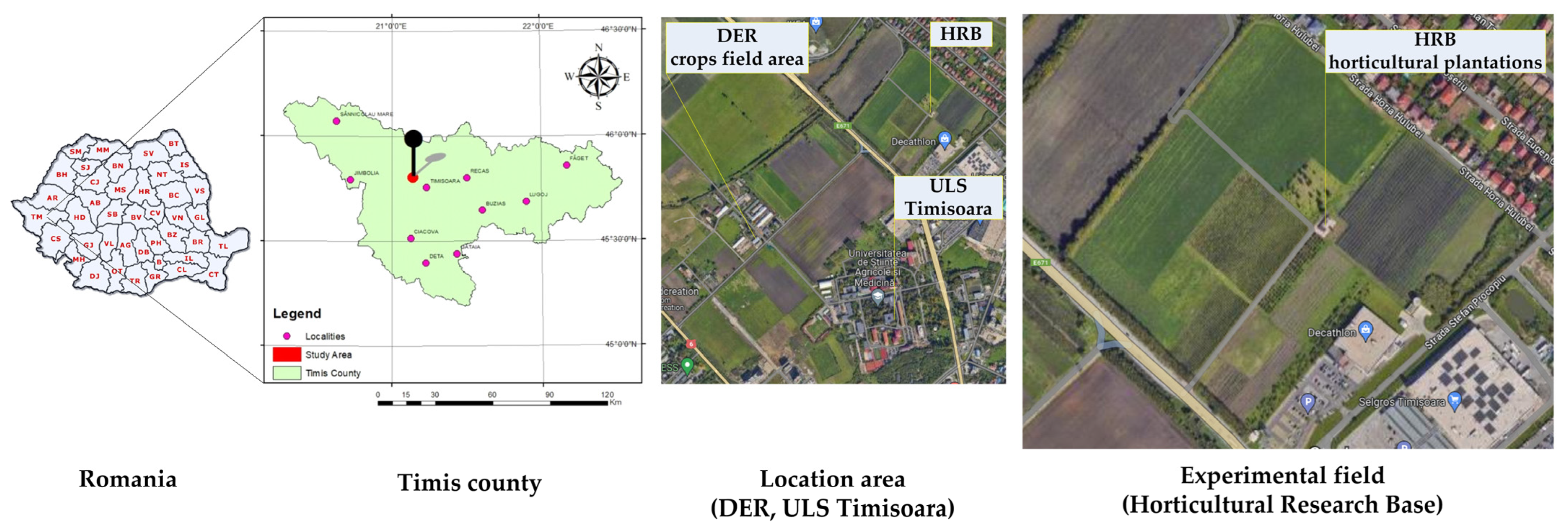
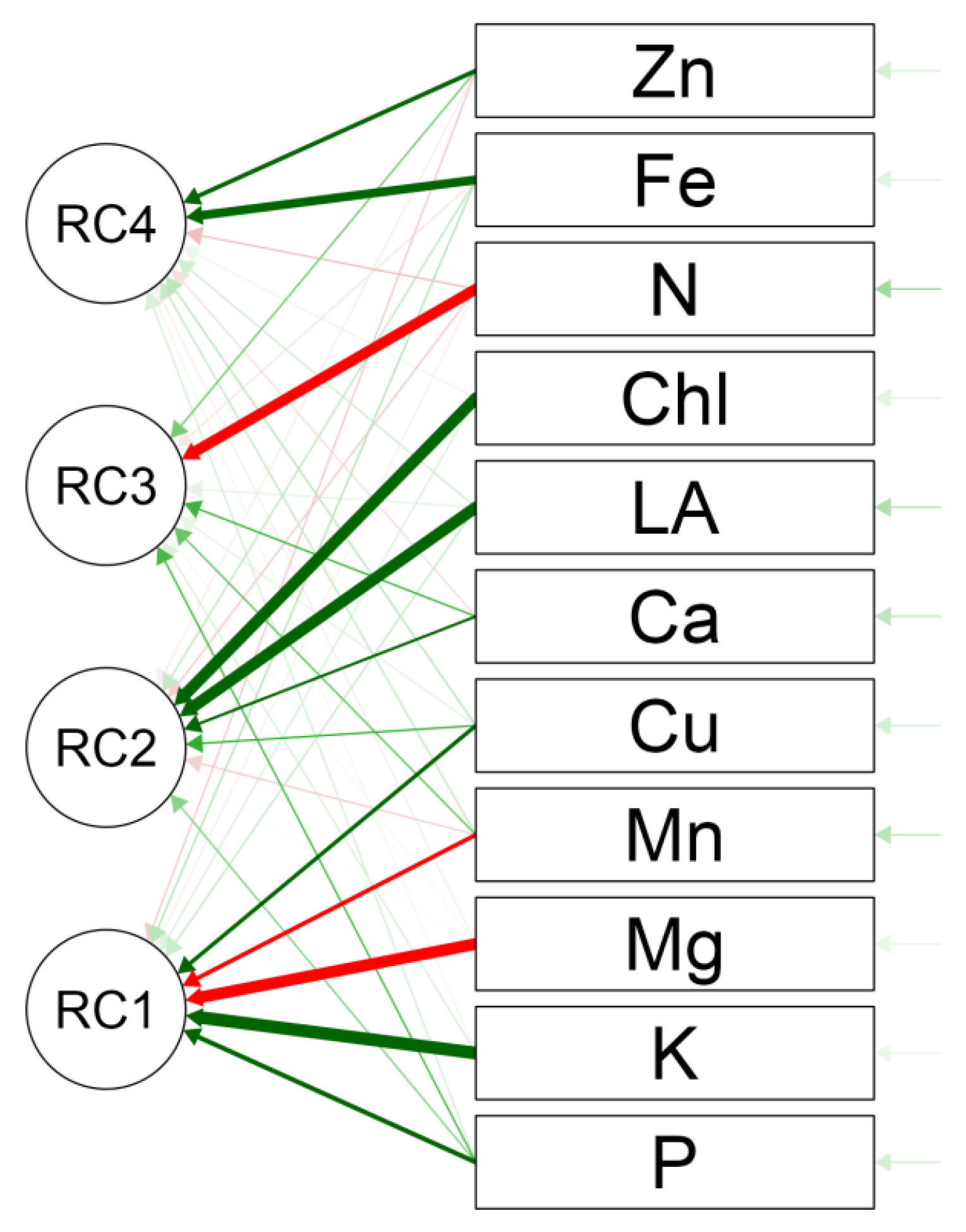
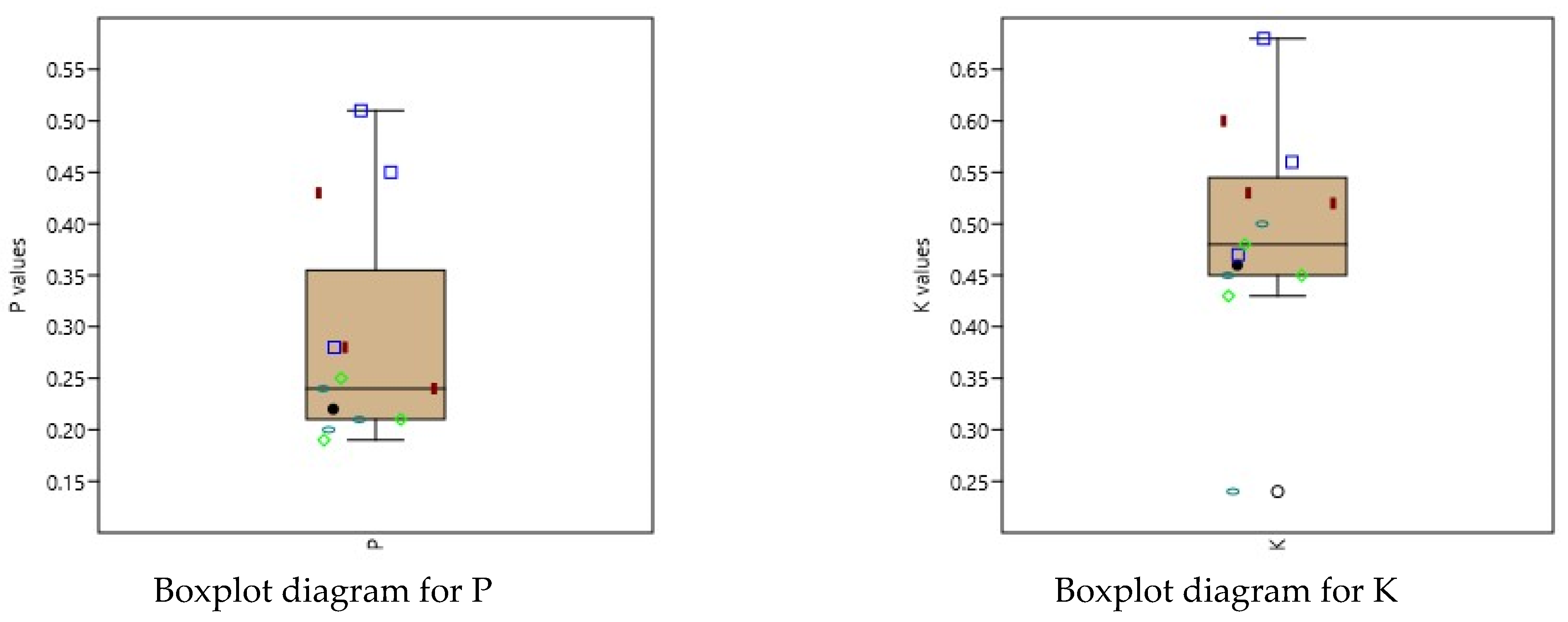
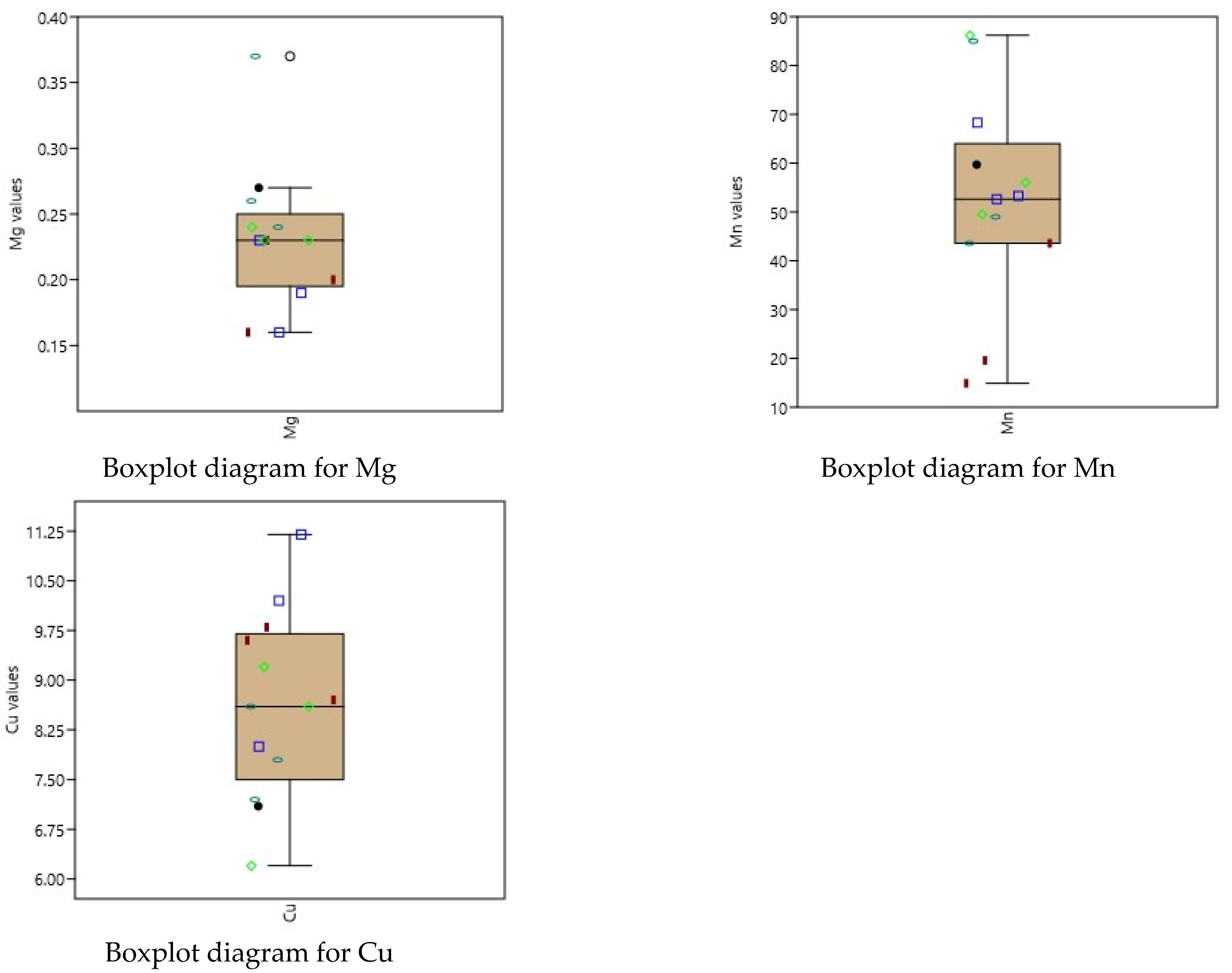
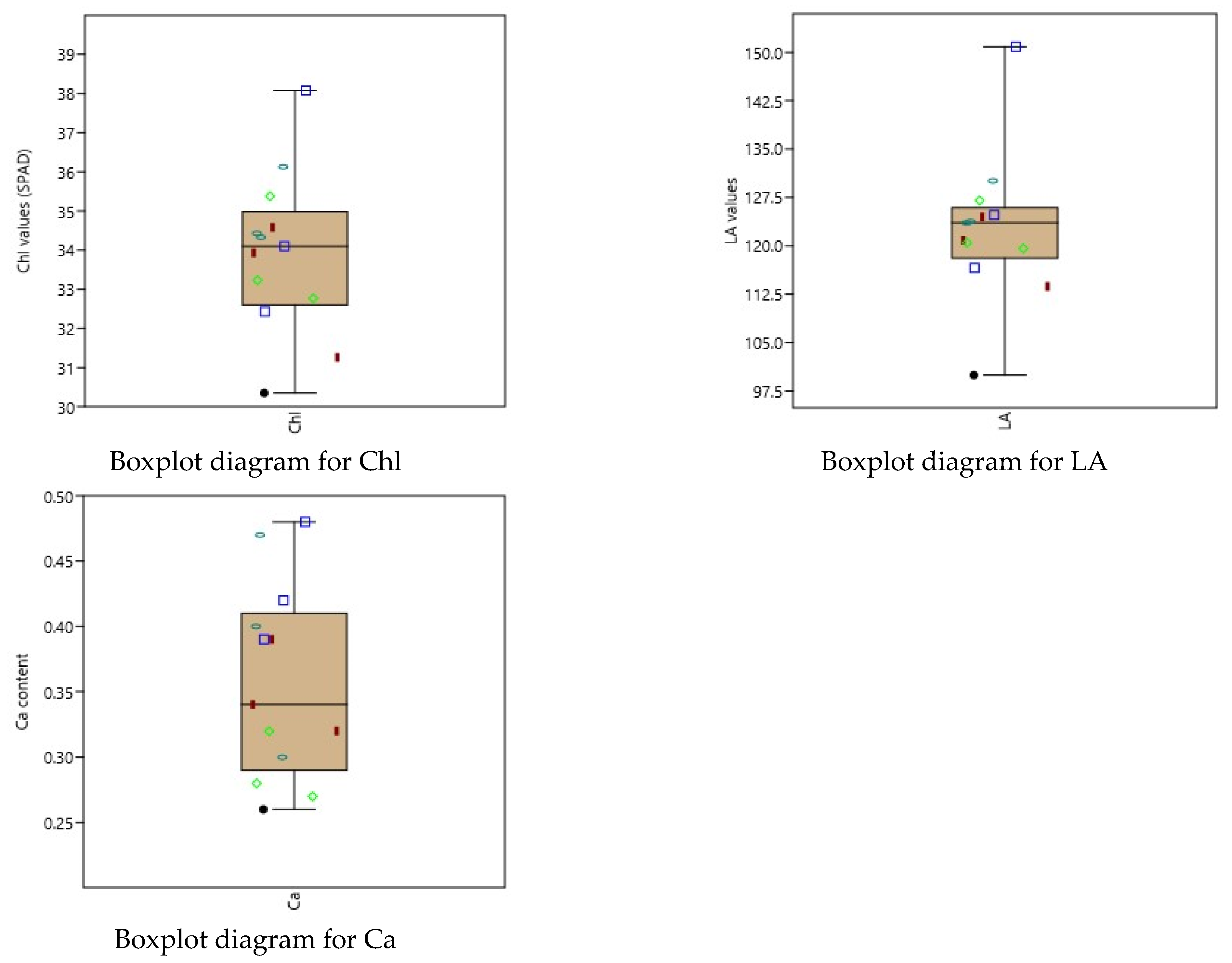
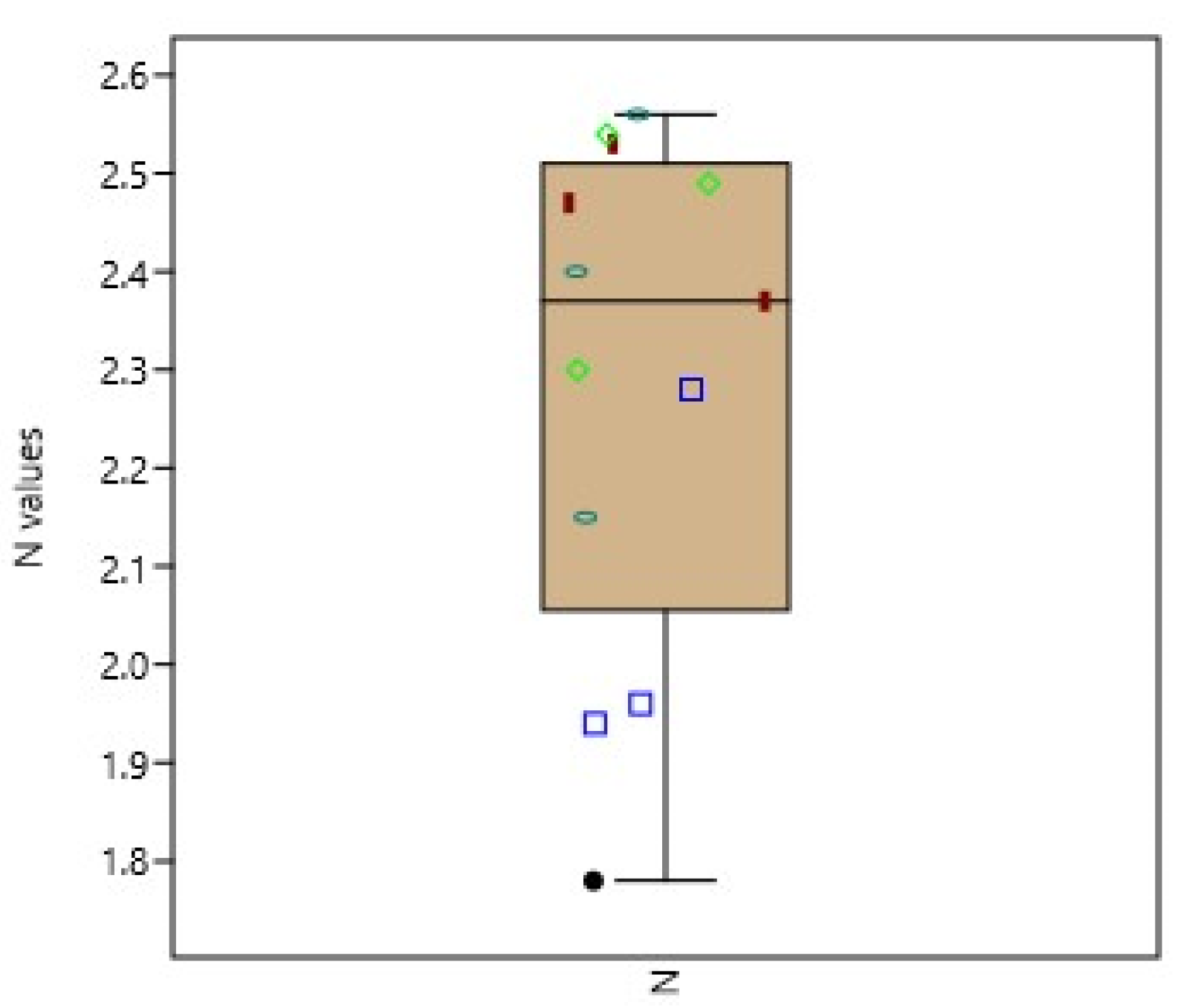
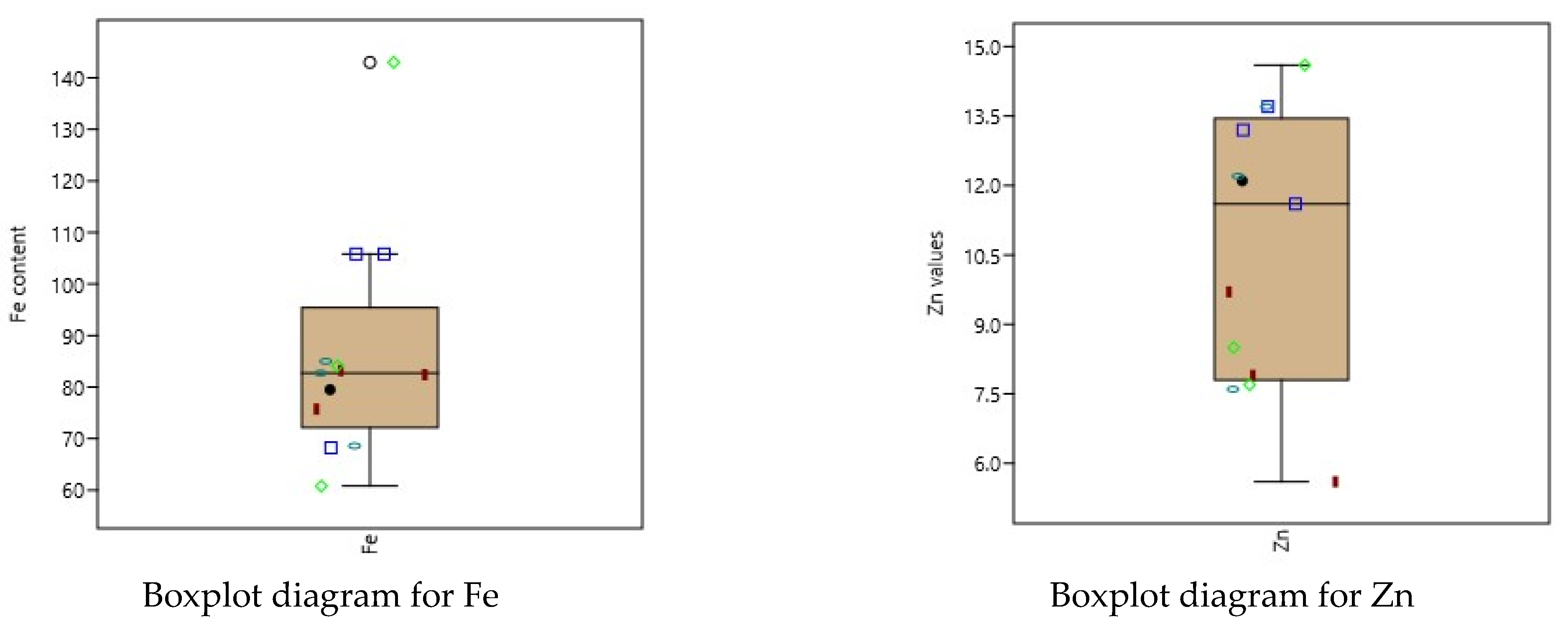
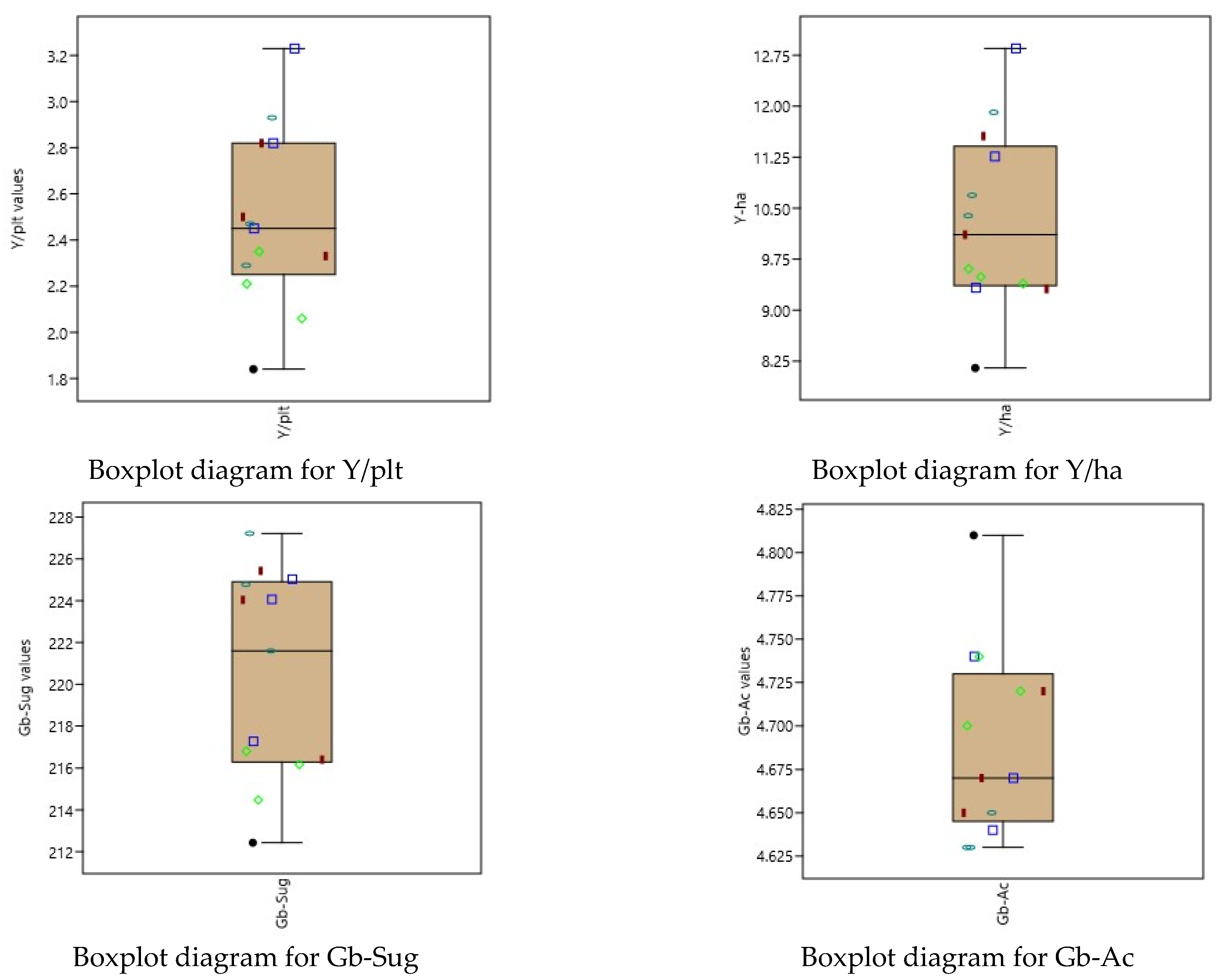
| Parameters | Measurement Unit (MU) | Soil Depth | |
|---|---|---|---|
| 0–20 cm | 20–40 cm | ||
| pH (H2O) | 7.33 | 7.19 | |
| Humus (H) | % | 3.14 | 2.04 |
| Phosphorus (P, mobile form) | ppm | 76.52 | 77.21 |
| Potassium (K, mobile form) | ppm | 490.20 | 243.30 |
| Magnesium (Mg, total form) | ppm | 4275 | 5188 |
| Iron (Fe, total form) | ppm | 12,465 | 39,614 |
| Manganese (Mn, total form) | ppm | 860 | 677 |
| Copper (Cu, total form) | ppm | 57.09 | 51.99 |
| Zinc (Zn, total form) | ppm | 73.44 | 80.36 |
| Trial | Content Of Mineral Elements In The Leaves | Physiological Indices | ||||||||||
|---|---|---|---|---|---|---|---|---|---|---|---|---|
| N | P | K | Ca | Mg | Fe | Mn | Cu | Zn | LA | Chl | ||
| Fertilizer | Code | (%) | (mg kg−1) | (cm2) | (SPAD) | |||||||
| Control | T1 | 1.78 | 0.22 | 0.46 | 0.26 | 0.27 | 79.50 | 59.70 | 7.10 | 12.10 | 99.96 | 30.35 |
| G.30t/ha | T2 | 2.37 | 0.24 | 0.52 | 0.32 | 0.20 | 82.40 | 43.60 | 8.70 | 5.60 | 113.69 | 31.26 |
| G.40t/ha | T3 | 2.47 | 0.43 | 0.60 | 0.34 | 0.16 | 75.70 | 14.90 | 9.60 | 9.70 | 120.84 | 33.93 |
| G.50t/ha | T4 | 2.53 | 0.28 | 0.53 | 0.39 | 0.23 | 83.20 | 19.60 | 9.80 | 7.90 | 124.46 | 34.58 |
| NPK 50 | T5 | 1.94 | 0.28 | 0.47 | 0.39 | 0.23 | 68.20 | 68.30 | 8.00 | 13.20 | 116.58 | 32.43 |
| NPK 100 | T6 | 1.96 | 0.51 | 0.68 | 0.42 | 0.16 | 105.80 | 52.60 | 10.20 | 13.70 | 124.79 | 34.10 |
| NPK 150 | T7 | 2.28 | 0.45 | 0.56 | 0.48 | 0.19 | 105.80 | 53.30 | 11.20 | 11.60 | 150.86 | 38.08 |
| Fertitel | T8 | 2.54 | 0.25 | 0.48 | 0.32 | 0.23 | 84.10 | 49.50 | 9.20 | 7.70 | 127.03 | 35.38 |
| Fertitel + Ca | T9 | 2.56 | 0.21 | 0.50 | 0.30 | 0.24 | 68.60 | 49.00 | 7.80 | 13.70 | 130.08 | 36.13 |
| Cropmax | T10 | 2.49 | 0.21 | 0.45 | 0.27 | 0.23 | 143.00 | 56.00 | 8.60 | 14.60 | 119.58 | 32.77 |
| Cropmax + Ca | T11 | 2.40 | 0.24 | 0.45 | 0.40 | 0.26 | 82.70 | 43.60 | 8.60 | 7.60 | 123.55 | 34.43 |
| Waterfert | T12 | 2.30 | 0.19 | 0.43 | 0.28 | 0.24 | 60.80 | 86.20 | 6.20 | 8.50 | 120.47 | 33.23 |
| Waterfert + Ca | T13 | 2.15 | 0.20 | 0.24 | 0.47 | 0.37 | 85.00 | 85.00 | 7.20 | 12.20 | 123.77 | 34.33 |
| Standard Error (SE) | ±0.071 | ±0.030 | ±0.028 | ±0.020 | ±0.015 | ±5.921 | ±5.764 | ±0.385 | ±0.811 | ±3.131 | ±0.560 | |
| Trial | Yield Data | Quality Data | |||
|---|---|---|---|---|---|
| Y/Plt | Y/ha | Gb-Sug | Gb-Ac | ||
| Fertilizer | Code | (Kg plt−1) | (t ha−1) | (g L−1) | (g L−1 H2SO4) |
| Control | T1 | 1.84 | 8.15 | 212.43 | 4.81 |
| G.30 t/ha | T2 | 2.33 | 9.31 | 216.41 | 4.72 |
| G.40t/ha | T3 | 2.50 | 10.11 | 224.04 | 4.65 |
| G.50t/ha | T4 | 2.82 | 11.56 | 225.43 | 4.67 |
| NPK 50 | T5 | 2.45 | 9.33 | 217.27 | 4.74 |
| NPK 100 | T6 | 2.82 | 11.26 | 224.06 | 4.64 |
| NPK 150 | T7 | 3.23 | 12.85 | 225.03 | 4.67 |
| Fertitel | T8 | 2.35 | 9.49 | 214.48 | 4.74 |
| Fertitel + Ca | T9 | 2.93 | 11.91 | 221.60 | 4.65 |
| Cropmax | T10 | 2.06 | 9.39 | 216.17 | 4.72 |
| Cropmax + Ca | T11 | 2.29 | 10.39 | 224.78 | 4.63 |
| Waterfert | T12 | 2.21 | 9.61 | 216.80 | 4.70 |
| Waterfert + Ca | T13 | 2.47 | 10.69 | 227.22 | 4.63 |
| Standard Error (SE) | ±0.105 | ±0.360 | ±1.377 | ±0.015 | |
| PC1 | PC2 | PC3 | PC4 | Uniqueness | |
|---|---|---|---|---|---|
| K | 0.963 | 0.060 | |||
| Mg | −0.940 | 0.113 | |||
| P | 0.770 | 0.049 | |||
| Mn | −0.759 | 0.216 | |||
| Cu | 0.752 | 0.079 | |||
| Chl | 0.938 | 0.109 | |||
| LA | 0.938 | 0.081 | |||
| Ca | 0.722 | 0.190 | |||
| N | −0.916 | 0.112 | |||
| Fe | 0.869 | 0.179 | |||
| Zn | 0.761 | 0.260 |
| Components | Unrotated Solution | Rotated Solution | ||||
|---|---|---|---|---|---|---|
| Eigenvalue | Proportion var. | Cumulative | SumSq. Loadings | Proportion var. | Cumulative | |
| Component 1 | 4.495 | 0.409 | 0.409 | 3.633 | 0.330 | 0.330 |
| Component 2 | 2.447 | 0.222 | 0.631 | 2.761 | 0.251 | 0.581 |
| Component 3 | 1.566 | 0.142 | 0.773 | 1.700 | 0.155 | 0.736 |
| Component 4 | 1.043 | 0.095 | 0.868 | 1.457 | 0.132 | 0.868 |
| Statistical Parameters | P | K | Mg | Mn | Cu | Chl | LA | Ca | N | Fe | Zn | Y/plt | Y/ha | Gb- Sug | Gb- Ac |
|---|---|---|---|---|---|---|---|---|---|---|---|---|---|---|---|
| N | 13 | 13 | 13 | 13 | 13 | 13 | 13 | 13 | 13 | 13 | 13 | 13 | 13 | 13 | 13 |
| Min | 0.19 | 0.24 | 0.16 | 14.9 | 6.2 | 30.35 | 99.96 | 0.26 | 1.78 | 60.8 | 5.6 | 1.84 | 8.15 | 212.43 | 4.63 |
| Max | 0.51 | 0.68 | 0.37 | 86.2 | 11.2 | 38.08 | 150.86 | 0.48 | 2.56 | 143 | 14.6 | 3.23 | 12.85 | 227.22 | 4.81 |
| Mean | 0.285 | 0.490 | 0.232 | 52.408 | 8.631 | 33.923 | 122.74 | 0.357 | 2.290 | 86.523 | 10.623 | 2.485 | 10.312 | 220.44 | 4.690 |
| Std. dev | 0.106 | 0.103 | 0.054 | 20.781 | 1.387 | 2.022 | 11.289 | 0.074 | 0.257 | 21.348 | 2.926 | 0.380 | 1.301 | 4.964 | 0.054 |
| Median | 0.24 | 0.48 | 0.23 | 52.6 | 8.6 | 34.1 | 123.55 | 0.34 | 2.37 | 82.7 | 11.6 | 2.45 | 10.11 | 221.6 | 4.67 |
| 25 prcntil | 0.21 | 0.45 | 0.195 | 43.6 | 7.5 | 32.6 | 118.08 | 0.29 | 2.055 | 72.15 | 7.8 | 2.25 | 9.36 | 216.29 | 4.645 |
| 75 prcntil | 0.355 | 0.545 | 0.25 | 64 | 9.7 | 34.98 | 125.91 | 0.41 | 2.51 | 95.4 | 13.45 | 2.82 | 11.41 | 224.90 | 4.73 |
| Coeff. var | 37.292 | 20.945 | 23.180 | 39.652 | 16.071 | 5.960 | 9.197 | 20.632 | 11.241 | 24.673 | 27.539 | 15.289 | 12.614 | 2.2516 | 1.1515 |
Disclaimer/Publisher’s Note: The statements, opinions and data contained in all publications are solely those of the individual author(s) and contributor(s) and not of MDPI and/or the editor(s). MDPI and/or the editor(s) disclaim responsibility for any injury to people or property resulting from any ideas, methods, instructions or products referred to in the content. |
© 2024 by the authors. Licensee MDPI, Basel, Switzerland. This article is an open access article distributed under the terms and conditions of the Creative Commons Attribution (CC BY) license (https://creativecommons.org/licenses/by/4.0/).
Share and Cite
Sala, F.; Camen, D.; Herbei, M.V.; Blidariu, C. Analysis of Vine Nutrition and Productivity Based on Statistical Indicators. Horticulturae 2024, 10, 397. https://doi.org/10.3390/horticulturae10040397
Sala F, Camen D, Herbei MV, Blidariu C. Analysis of Vine Nutrition and Productivity Based on Statistical Indicators. Horticulturae. 2024; 10(4):397. https://doi.org/10.3390/horticulturae10040397
Chicago/Turabian StyleSala, Florin, Dorin Camen, Mihai Valentin Herbei, and Cosmin Blidariu. 2024. "Analysis of Vine Nutrition and Productivity Based on Statistical Indicators" Horticulturae 10, no. 4: 397. https://doi.org/10.3390/horticulturae10040397





